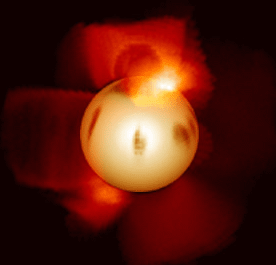A star that rotates with a twist has been observed for the first time, confirming a long-predicted magnetic phenomenon known as the Applegate effect. Andrew Collier Cameron and Jean-Francois Donati used the Anglo-Australian Telescope in New South Wales to track ‘star-spots’ on the surface of a sun-like star for eight years. The observations could explain why the stars in some binary systems have erratic orbits (A Collier Cameron and J-F Donati et al 2001 Mon. Not. R. Astron. Soc. 329 L21).

Star-spots – like sunspots – are dark patches on the surface of a star caused by intense local magnetic fields. These fields suppress the convection of heat to the surface, which leads to cooler patches that radiate less light. Collier Cameron, of the University of St Andrews in the UK, and Francois, of the Observatoire Midi-Pyrénées in France, monitored the rotation of these spots on a star known as AB Doradus, which is 50 light years from Earth.
Collier Cameron and Francois found that star-spots at the equator of AB Doradus completed a circuit of the star every twelve hours – much more quickly than those at its poles. But over an eight-year period, they noticed that the equatorial spots slowed down and the polar spots speeded up. The researchers point out that they have not observed the star for long enough to know whether this effect is cyclic, but the rate of change suggests that the process takes a decade or two.
According to the Applegate effect, star-spot motion is linked to the rotation of the star, which determines the degree to which the star is gravitationally ‘flattened’. Collier Cameron and Francois have now confirmed that the variation in star-spot speed on AB Doradus could significantly affect its gravitational field – and they believe that this effect could explain the highly irregular orbits of the stars in some closely bound binary systems.
Collier Cameron and Francois are also optimistic that their studies of AB Doradus will help astronomers to understand the magnetic processes that give rise to the 11-year cycle of activity in the Sun. The researchers found in an earlier study that – similar to the Sun – star-spots at the equator of AB Doradus rotate faster than those at the poles. But the sunspots at the Sun’s equator rotate fifty times more slowly than similar spots on AB Doradus.



